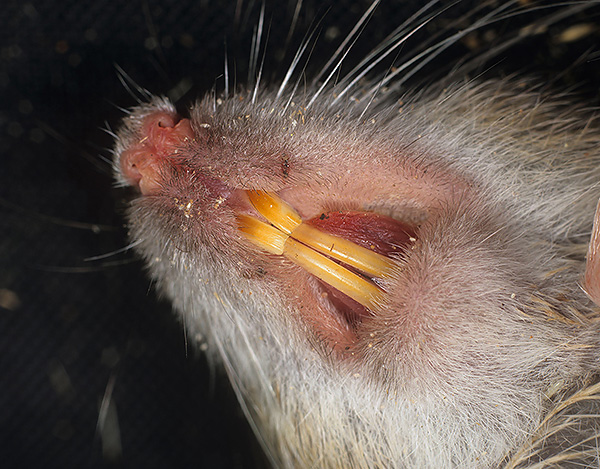
About 100,000 rat attacks on humans are recorded annually in the world. At the same time, according to official statistics, only one rat bite out of 36 becomes known to health authorities and falls into this very statistics. That is, in fact, up to 3.5 million people all over the world become victims of rat attacks every year, a significant part of which are children.
Perhaps the first thing to keep in mind is that if you or your child is bitten by a rat, you don’t need to panic: it’s not fatal, but the probability that a bite will infect a dangerous disease, although it is, is very small. In addition, with the help of fairly simple actions, the risk of developing undesirable consequences after a rat bite can be minimized - we will talk about this in more detail below.
On a note
However, even without infection, the rat can cause serious injury with its sharp teeth. There are cases when these animals bit a person a piece of the ear and even broke a finger (a crack in the bone). And in especially impressionable victims, a sudden rat attack can cause the development of phobias and various nervous disorders that can accompany a person for years, sometimes for the rest of his life. For children, all this is especially true.

So, let's see what needs to be done when a rat bites immediately, that is, literally in the first minutes after the attack of a rodent - the possible consequences of the bite depend in many respects on how correctly and promptly the measures are taken ...
The first actions after a rat bite
The first thing to do after a rat bite is to rinse the wound with water and treat it with any highly effective antiseptic. For this, you can use, for example, an alcoholic solution of iodine, brilliant green, hydrogen peroxide, Miramistin or Chlorhexidine.
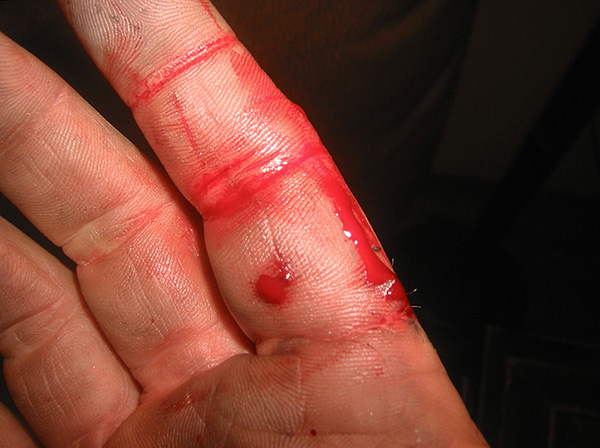

Since rats often bite to blood, and the wound is deep enough, treatment should be carried out without waiting for the bleeding to stop. The wound should be treated carefully, including even minor scratches - this will be a reliable protection against infection. After this, it is useful to bandage the bite site for at least several hours to prevent mechanical damage to the wound and contamination from outside (if this is not done, the risk of suppuration of the wound in the future increases).
On a note
If a rat has bitten a small child, it must first be reassured. You can joke, remember the character of a cartoon, tell what kind of hero the baby is now. It is also useful to shift the emphasis and say that the animal was frightened of the big boy (girl) and therefore bit. Otherwise, the child will consider that all rats are aggressive and very dangerous, and this is a direct road to phobia.
Remember: the sooner the baby calms down and is distracted, the lower the risk of developing the psychological consequences of the incident. And in the case of very impressionable adults (especially women), this step should not be ignored - without emergency psychological help, a bitten woman may experience hysteria and even fainting.
In general, after a rat bite, you should not get hung up on thoughts about possible dangers and infections. Although it is widely believed that rat saliva is a broth with microbes and viruses, in fact, disease infections with rodent bites rarely occur, mainly in conditions of total unsanitary conditions in third world countries.

Meanwhile, although the bite, most likely, will not have any serious consequences, nevertheless, it is worth observing the state of the wound, and consult a doctor at the first signs of the development of a complication. Moreover, the most dangerous consequences of rat bites do not develop immediately, but several days (or even weeks) after the attack of the animal, when the wound is completely healed.
On a note
Special studies have shown that even if nothing is done after a rat bite to disinfect a wound, the risk of contracting an infectious disease when attacked by an animal does not exceed 2%. Already after simple washing of the wound, conditionally pathogenic or pathogenic bacteria were found in it in only 30% of cases, of which in 43% of situations, these bacteria were staphylococci, normally not dangerous to health and always located on the surface of the human body. Processing a bite with an antiseptic allows you to destroy almost all bacteria in damaged tissues. In other words, if you make a simple but timely treatment of a wound, this will almost completely eliminate the risk of infection with a rat bite.

Still, it’s useful to know what the consequences of rat bites can sometimes be. If you are aware, you can figure out what to do in a particular situation ...
Possible consequences of rat bites
As noted above, a rat bite is dangerous, primarily, the risk of infection with infectious diseases. Such infection rarely occurs, but the infections themselves can be very serious (and deaths after infection with them are enough good reason to carefully monitor the condition of the victim).
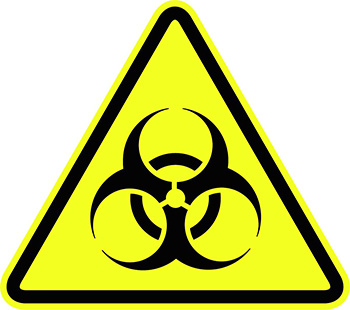
A rat bite itself can cause the following diseases:
- Sodoku, which is called “rat bite disease”. According to statistics, if sodoku is not treated, then in about 10% of cases it leads to the death of the patient. However, with the initiation of therapy, the person is cured quickly and completely;
- Tetanus is a dangerous disease that requires the most intensive treatment. Every year, from 30 to 60 thousand people die from it all over the world, mostly children, and the mortality rate is very high - about 20-25%. According to this indicator, tetanus is in the top three most deadly infectious diseases after rabies and pulmonary plague. Complications of this disease are also dangerous - heart paralysis, pneumonia, sepsis. With rat bites, tetanus develops extremely rarely, but such a risk is present;
- Leptospirosis - from rats is transmitted more often than other infections, and the susceptibility of people to its pathogen is very high. The disease is difficult, in half of cases it requires treatment in the intensive care unit. Among its complications are paralysis, myocarditis, acute renal failure, toxic toxic shock;
- Pseudotuberculosis (yersiniosis), the main danger of which is the possible development of complications - meningitis, polyarthritis, osteomyelitis and myocarditis.
But rabies with a rat bite is almost impossible to get infected. There are literally few such cases, and in each of them it was impossible to reliably state that the infection occurred precisely from rodents.
It should be borne in mind that opportunistic bacteria can sometimes get into the wound itself, which sometimes lead to inflammation and suppuration. If the victim is shown to the doctor, this situation is not dangerous: the abscess can be opened and drained, and then disinfection of its cavity can be carried out.
Such abscesses pose a threat in their neglected form - they can develop into ulcers (especially in hot and humid climates), abscesses and gangrene. And these consequences, in turn, are fraught with blood poisoning or the need for amputation of a limb. Today this happens extremely rarely.
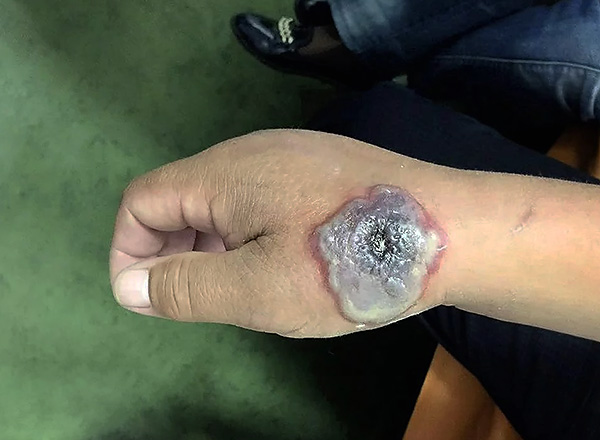
In addition, it is important to understand the following pattern: if a rat has bitten a person, then it lives next to it. And the fact of such a neighborhood is often no less dangerous than the bite itself.Most infections from rats are transmitted through an alimentary route - through stained and contaminated food, water, and household items. And even if an infection does not occur with a bite, it can happen at any other time when a person does not see or hear a rodent, but eats, for example, bread that has already undermined the pest at night. Moreover, in this way, infections from rats are transmitted much more often than directly with bites.
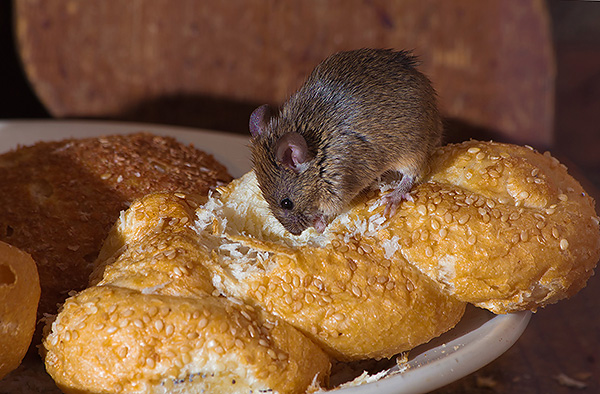
On a note
It was because of the proximity of rats in the history of human civilization that several hundred million people died - more than in the most bloody wars combined. Animals simply couldn’t physically be able to bite so many people, but the fleas living in the coat of rats were completely (these blood-sucking parasites infected people with the plague). And today all these problems have not gone away: every year in the world several thousand people die from the plague, and besides it, fleas carry typhus, anthrax and other diseases from rats.
Another danger is the bite injury itself. It would seem that it is unlikely that an animal weighing about 100-200 grams can seriously injure a person. It turns out maybe. For example, there are widely known cases when rats bit off earlobes to sleeping people, nibbled skin on their heels, bit their nose wings. Moreover, in children such injuries occur more often than in adults.
Here are the dry statistics:
- 62% of rat bites are just small wounds;
- 14% of bites - lacerations up to 1 cm long;
- 12% - abrasions;
- 6% - bruising under the skin;
- 5% - hematomas;
- less than 1% - fractures (finger fractures were recorded).
The photo below shows an example of a rat bite:
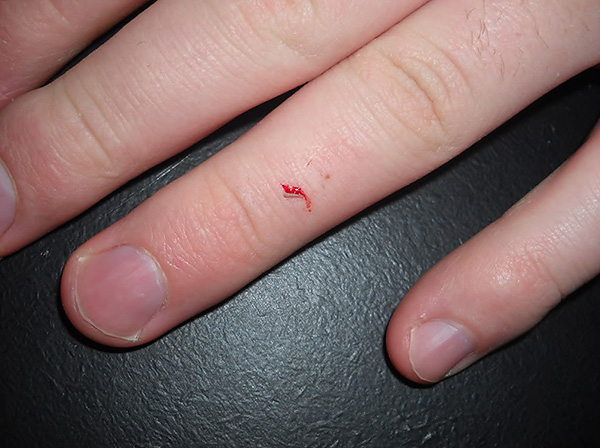
And in this photo - an ear with a scar after an animal attack:
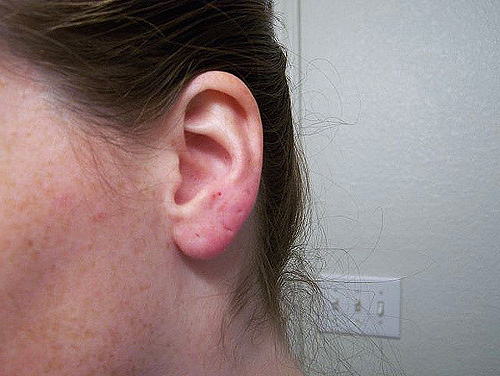
In practice, in most cases, rats bite people by the arms, less often - by the legs, and even less often the face suffers. This is confirmed by the fact that most often rats do not bite for no reason, but only use their teeth for self-defense when they try to catch them.
A rat can bite a sleeping person. In slums and impoverished areas of cities in developing countries, most of the attacks of these animals are associated with the bites of sleeping people. In developed countries, the number of rat attacks on sleeping people is very small.
It is interesting
As mentioned above, rat bites can have psychological consequences. In addition to simply fearing rats, there are specific phobias - for example, it is widely known that rats can enter the apartment through the toilet, getting into it from the sewer system through a water trap (in megacities this trick is not uncommon). Accordingly, the appearance of a rat in the toilet in the future often often causes an irresistible fear of a toilet in a person.
What symptoms indicate infection?
There is a whole set of characteristic signs, with the appearance of which a person bitten by a rat should be shown to a doctor as soon as possible.

The most common diseases that occur a few days (weeks) after rat bites are manifested by typical fever with characteristic symptoms:
- Fever;
- Chills;
- Severe malaise and general weakness;
- Pain in the head;
- Digestive disorders, diarrhea, nausea, abdominal pain.
These are signs of most viral and bacterial fevers, leptospirosis and pseudotuberculosis. As a rule, they develop in about a week or two after a bite, but sometimes the incubation period is delayed to a month, or, conversely, it lasts just a few hours or a day. This, by the way, is one of the difficulties of diagnosis - often by the time symptoms appear, a person already forgets that he was bitten by a rat.
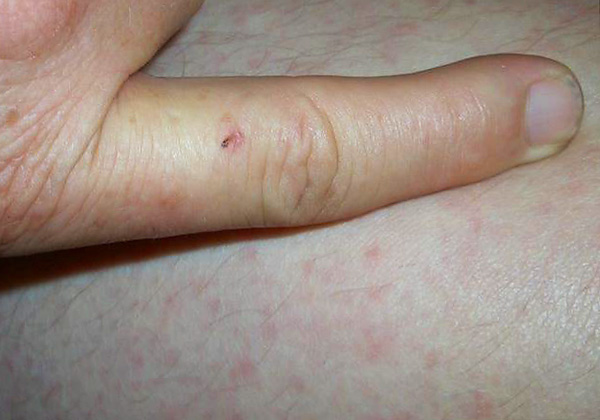
Here, for example, the characteristic features of tetanus:
- Acute pain at the site of the bite, even if the bite itself has long healed (a few weeks after the attack of the rat);
- Muscle twitching at the site of the bite;
- Chewing muscle tension, sometimes not allowing you to open your mouth;
- Insomnia;
- Excruciating back pain.
With soda, in addition to pain at the site of the wound, an infiltrate with a constantly flowing fluid can develop. With nonspecific local infection, painful inflammation first appears here, and then a characteristic abscess.
In general, you do not need to remember these symptoms. Any violation of the general state of health of the victim within a few weeks after the attack of the rat is likely to be associated with the bite itself. Moreover, the first “bell” can be not only a generalized sign, but also local manifestations - pain, itching, spontaneous muscle contractions near the wound, even if it has healed. None of them can be ignored, and with a clear manifestation of symptoms, you should see a doctor as soon as possible.
Differences between rat bites and other animal bites
In some cases, it is not even clear who specifically bit a person - a rat, a mouse, or some other animal. For example, a bite can occur when a person is sleeping, or someone bites a child by the finger when he plays in the house or on the street. It is even more difficult to identify the offender if the pet is bitten.

In general, it is not difficult to distinguish a rat bite from a bite of another animal. After a rodent attack, as a rule, two small bleeding wounds remain on the bite site - from the upper and lower incisors (sometimes such wounds are represented by two closely located skin lesions, since the rat has two upper and two lower incisors well developed). Such a "pattern" is characteristic of rodent bites.
The photo below shows what a rat bite looks like on a person’s hand:

Perhaps the easiest way to confuse such a bite with the bites of other rat relatives: mice, voles, hamsters. The rat differs from them only in size (however, there is no need to make such a diagnosis, since all wild rodents are about as dangerous as rats).
Are bites from decorative rats and animals in pet stores dangerous?
Bites of domestic (decorative) rats are practically not dangerous. The risk of infection is minimal, because decorative animals are usually healthy and are not carriers of pathogens. Yes, and tame pets do not bite as violently as wild rats, and therefore the wounds left by them are rarely deep (usually the animal does not even bite the skin).
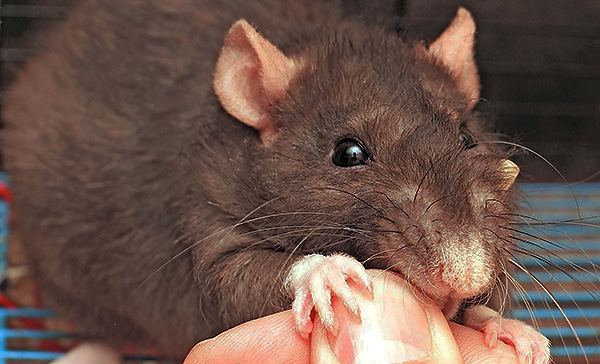
Nevertheless, if a decorative rat has bitten to the blood, suppuration of the wound can still occur, and therefore, in any case, the bite must be fully treated.
Similarly, if a rat bites a child in a pet store, the wound must be disinfected, for example, lubricated with iodine and bandaged. You don’t have to do anything else. Certainly this is not a reason to kill the animal and carry its corpse for examination, since rats are usually healthy in pet stores (the rage that parents usually start to worry about is out of the question).
What to do if rats bit the children in the kindergarten?
In many cases, rat bites require not only therapeutic, but also administrative measures. Still, in accordance with sanitary standards, there should not be any rats, no mice, or any other rodents in the premises next to a person. And if in his home a person is responsible for preventing their appearance, then in various educational institutions it is quite possible to demand that these measures be followed by the administration.
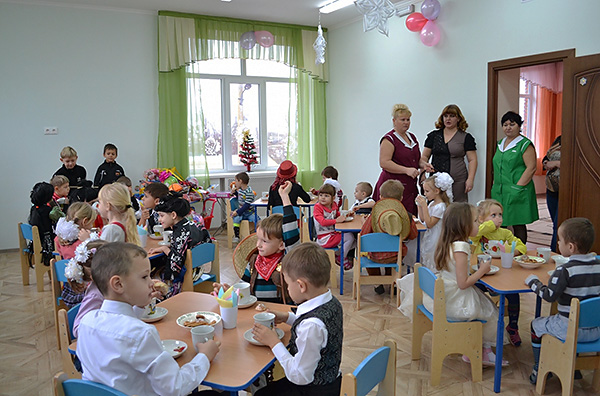
For example, if rats bit the children in the kindergarten, there is a flagrant violation of sanitary standards. What should be done if the kindergarten administration did not take anything in response to such an emergency?
- To compose and send an application to the regional branch of the SES. As a rule, the service responds to complaints regarding municipal enterprises promptly;
- Send an appeal to the deputy head of the city administration;
- If there is no reaction from the deputy head and SES, write a complaint to Rospotrebnadzor.
It is very important that all complaints and appeals are collective, from at least three to four parents. This will help the employees of the relevant services to distinguish the real problem from the far-fetched complaints of a single mother-brawler.
It is advisable to attach copies of certificates from the polyclinic to all appeals, where the doctor examined the bitten children, as well as photographs and copies of letters to other authorities from which no response was received.
If a rat has bitten a pet ...
Adult pets usually do not need first aid after a rat bite. Cats and dogs themselves will carefully lick the bite site, and their saliva is not much less effective antiseptic than iodine or brilliant green.
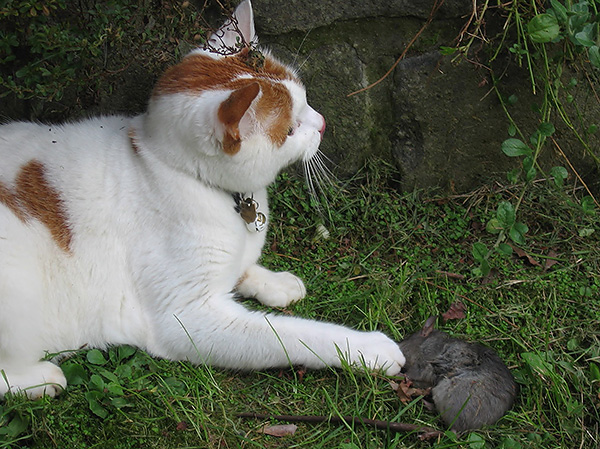
Serious treatment is necessary for a wound in a kitten or puppy, who still do not know how to lick, but have already been weaned from their mother. In this case, the baby needs the same first aid as a bitten person: wash the wound, treat it with an antiseptic and, if possible, bandage it. The same measures must be taken if the rat has bitten a cat or a dog by the nose or ear - parts of the body that animals cannot fully lick (well, unless you can do without bandaging).
If after a bite the pet has symptoms of the disease, you should contact your veterinarian as soon as possible. In particular, sometimes the pet has spasms of the spinal muscles, gait disorders, he cannot open his mouth and chew food normally - in such cases, the doctor should be called immediately. It is with these symptoms that tetanus manifests itself, and when they appear, the count of time goes literally on the clock. Independently decide what to do in such a situation, and even more so - to use the medicine at your discretion, should not be.
Useful video: what to do with a rat bite (first aid)
Rats bit children in kindergarten ...


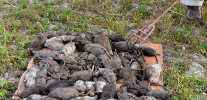

Good afternoon. I was bitten by a rat, and I almost died in the hospital. She bit me by the eye. I had surgery, but I survived.
Lord ... Thank God that he survived ...
Is it dangerous to eat a watermelon, on the peel of which there is a trace from a bite of some animal (possibly a rat)? The bite was dried, shallow, did not reach the pulp.
What redneckness - to eat up a watermelon behind a rat)) It's not too lazy to ask a question on the Internet and wait for an answer 🙂
My mother was bitten by a rat on her left foot. Mom was taken to the emergency room, I hope that everything will be fine.
I bit my lip, kapets. Now I'm looking on the Internet for how much.
My three-month-old child was bitten by a rat, they were at the doctor's office - they gave an injection. I process with peroxide, smear with Levomekol ointment and green stuff. Better to bite me. It's a shame, I thought I would go crazy ...